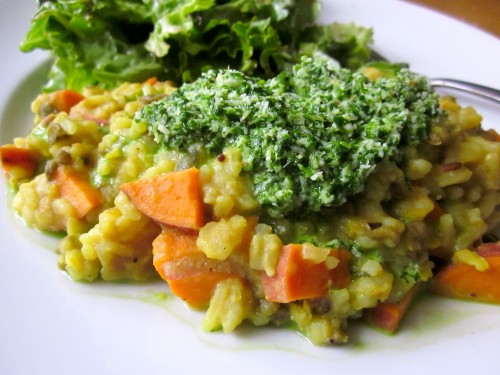Bonus Read: One Spice to fix all imbalances.
If any food could wear a cape and fly, it would be Kitchari.
Kitchari kicks *ss.
It’s a complete protein, heals digestive distress, balances the metabolism, cleans your liver, assists in healthy weight loss and is a breeze to make! If you can make oatmeal, you can make Kitchari.
Kitchari is best known as the all-star of Ayurvedic cleansing. What makes it so unique is that while it helps detoxify the body (making it great when those extra pounds sneak onto to your body or when you’re feeling like you need a break from coffee/chai/vegan donuts/tofu dogs), it’s also nourishing and easily digestible.
Your body will feel so good that extra weight will fall off, you’ll sleep better, your digestion & elimination will improve and your skin will shine.
There are millions of variations on Kitchari, but here’s one that I especially love in the spring & summer. If you know your dosha (Ayurvedic body-mind type) there are extra suggestions at the bottom of the recipe. Enjoy!
Kate’s Kitchari
1 cup white basmati rice
1/2 cup mung beans, soaked overnight (either split mung beans or whole beans)
1 T ghee (clarified butter) Make it at home or buy it at the store.
1 t fennel seeds
1 t cumin seeds
1 t ground turmeric
2 coins of fresh ginger (thick slices)
5-6 cups water
1 t coriander seeds
1 T sesame seeds
1 T desiccated coconut
3 leaves of Swiss chard
1 zucchini
1/2 t salt
cilantro
lime wedges
Instructions
Rinse rice and beans well and set aside. In a medium to large pot, heat ghee over medium heat. Once the ghee has melted, add fennel, cumin, and turmeric. Stir, then add rice and beans and combine well. When rice & beans begin sticking to the sides of the pot, add ginger, water, and coriander seeds. Cover and bring to boil.
Meanwhile, in a small pan, heat sesame seeds until starting to brown then mix in the coconut. Once coconut starts to brown, turn off the heat and promptly add to the boiling rice mixture. Stir and set a timer for 20 minutes to allow rice and beans to cook.
Now is a good time to chop the chard, grate the zucchini, and chop any cilantro you’ll be using to garnish and further enhance digestion. About ten minutes in, check that the rice and beans don’t need more water. If it’s not looking like a wet porridge then add more water.
After the timer goes off, check that the beans & rice are cooked. Depending on your bean and how long you soaked them, it may need another 10 minutes. Don’t worry if the rice grows soft; it only makes it easier to digest & it stays tasty.
Once rice and beans are cooked, add vegetables and mix well. Add more water if necessary, then cover and allow vegetables to cook to finish the dish; this shouldn’t take more than five minutes or so.
To serve, sprinkle with fresh lime juice and chopped cilantro.
For Vata Dosha: Very good. Can add more ghee to top. Could add a pinch of hing (asafetida) to the melted ghee at the start.
For Pitta Dosha: Excellent!
For Kapha Dosha: Good. Reduce coconut to 1 t and use bell pepper rather than zucchini. Can add any other more pungent spices like 1/2 t of fenugreek or a sprinkling of garam masala to taste to bring more heat.
Kate Lumsden, a San Francisco-based Ayurvedic Practitioner & Yoga Teacher, spreads her love for these healing practices in her home city and beyond (via phone & skype) through her recipe blog, group cleanses, yoga classes and wellness coaching practice. Catch her on Facebook or Twitter where she posts regularly on how to weave Ayurveda into everyday life in fun, juicy ways.
 Share on bsky
Share on bsky


Read 38 comments and reply